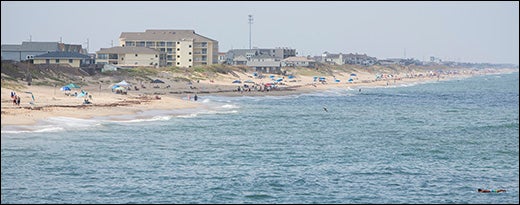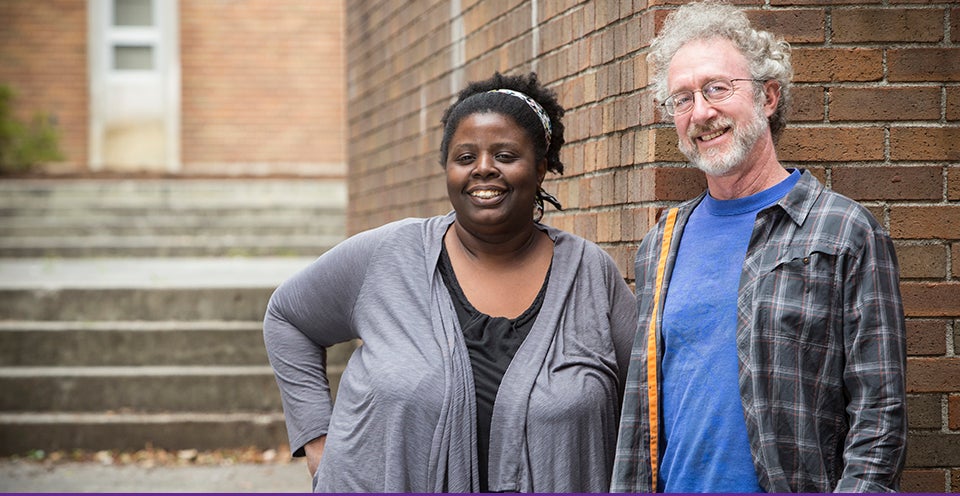GAME-CHANGING RESEARCH
Collaborative project could yield energy from coastal waters
Researchers from East Carolina University, N.C. State University, the University of North Carolina at Chapel Hill and the Coastal Studies Institute will begin work this summer on a project that could derive energy from coastal waters while also cleaning wastewater.
Andrew Keeler, an ECU professor of economics who’s based at the Coastal Studies Institute in Manteo, is working on the numbers and policy side of the project to show that it’s financially feasible and environmentally desirable.
The concept is called salinity gradient energy, and it is the energy available from the difference in the salt concentration between different types of water. This project will study the technical and economic feasibility of using reverse electrodialysis to access that energy and more.
Reverse electrodialysis generates electricity as ions, such as sodium and chloride, flow across ion-selective membranes from salt water into fresh or brackish water. It can also store electricity by creating salinity gradients and partially treat wastewater by using devices called microbial fuel cells.

North Carolina’s coastal communities could benefit from new research on the state’s coastal estuaries, where fresh and salt water mingle, in an attempt to derive energy from the waters.
It’s unlike many energy proposals, Keeler said, which either cannot be scaled in size or are many years down the road – or both. With North Carolina’s system of fresh and marine waters, its impact could be significant for coastal communities that need energy and water treatment.
“Under what circumstances does it make economic sense for a community to replace septic or water treatment plants?” he said. “What set of circumstances makes this technology a good choice?”
The project is funded by $997,966 from the University of North Carolina system, which last month announced a total of nearly $9 million in grants to support what it calls “game-changing faculty research in areas of strategic importance to the state.”
At ECU, Keeler is being assisted by Zaneta Adme, who’s working on her doctorate in coastal resource management. A Mount Olive native, she has a civil engineering degree from Florida State University and a master’s degree in economics from ECU. She developed the model that determines the economic merits of the salinity gradient project and what barriers communities would face if they wanted to use the technology.
The project will begin in July and is led by Doug Call, an assistant professor of civil, construction and environmental engineering at N.C. State. Orlando Coronell, assistant professor of environmental sciences and engineering at UNC-Chapel Hill’s Gillings School of Global Public Health, is a co-principal investigator with expertise in membrane technology.
Lindsay Dubbs, a research assistant professor at the Coastal Studies Institute, is also a co-principal investigator. She will investigate potential environmental impacts of the technology. A comprehensive energy system and life-cycle analysis of reverse electrodialysis will be conducted by another co-principal investigator, Joseph DeCarolis, who is an assistant professor of civil, construction and environmental engineering at N.C. State.
In reverse electrodialysis, salt and fresh water move through a stack of alternating anion- and cation-exchange membranes. The flow of ions is converted into electricity at two terminal electrodes, generating a voltage. The process is similar to how a battery converts chemical energy to electrical energy.
The bigger the difference in the salinity of the waters being mixed, the greater the potential for electricity production. North Carolina’s estuaries, where vast amounts of fresh and salt water mingle, provide a prime laboratory.
“That’s the advantage of the coast here,” Call said. “We have lots of different gradients we’re going to test.”
At first, the research will be done in a laboratory at N.C. State using water collected from coastal areas, Call said. Field research could come later.
In addition, off-peak wind and solar electricity can be stored by operating reverse electrodialysis in the opposite direction. The result is a salty solution and a less-salty one that can be converted back into electricity with the same technology when needed. And by using microbial fuel cells, the microbes feed on wastewater, which results in further electricity generation. The primary byproduct of the process is brackish water, which is what’s in the estuaries already.
The idea of using the world’s salt water as a source of electricity arose in the 1950s. By the 1970s, practical methods of exploiting the electricity potential using selectively permeable membranes were described and tested.
During the past decade, the technology has been used in the Netherlands to generate electricity where fresh water flows into salt water. A 200-megawatt demonstration plant is planned there.
“There is still a lot that needs to happen before we see more widespread use of it,” call said. “One of our goals is to make technological advancements so that the system is more efficient and less expensive. While we are doing that, we want to show that North Carolina source waters along the coast can be used to generate power. As far as we know, no one else in the U.S. is doing this, so it would be great to show that North Carolina is leading U.S. efforts in this area. This will hopefully attract commercial interest in making pilot-scale, and in the long term, full-scale demonstrations a reality.”
In addition to the universities, the research team comprises local start-up companies, consultants and coastal utilities. Together, they will conduct a comprehensive technical, economic and environmental assessment of this technology and its impact on North Carolina. The findings will help expand North Carolina’s clean energy sector, attract industrial investment and provide foundational research for future funding opportunities in coastal energy technology development.
The first round of the UNC Research Opportunities Initiative, as the grant program is called, also supports research ranging from developing new carbon electronics to supporting big-data science analytics to engineering new drug-delivery technologies to speeding the large-scale manufacturing of vaccines against deadly viruses such as Ebola.
All the research projects include faculty members from at least two UNC-system schools.
UNC ROI is funded by a recurring $3-million annual appropriation from the 2014 General Assembly, representing North Carolina’s first financial investment in the UNC system’s five-year strategic plan. Priority research areas eligible for ROI funding include advanced manufacturing; marine and coastal science; defense, military, and security; pharmacoengineering; energy; and data sciences.
“The ROI provides targeted funding for innovative and potentially game-changing projects,” said Christopher Brown, UNC vice president for research and graduate education. “These awards, which will advance cutting-edge research at UNC institutions, also demonstrate legislators’ growing appreciation of the role university research can play in supporting economic development across our state.”
The competitive selection process began with 74 proposals seeking $105 million in total funding, UNC officials said.
Other funded projects are as follows:
- N.C. Carbon Materials Initiative: Materials Design, Processing and Manufacturing for Defense and Energy Needs, N.C. State, $2.8 million. Partnering institutions include North Carolina Central University and UNC-Chapel Hill. Led by Harald Ade of N.C. State.
- Pharmacoengineering: Integrating Engineering with Pharmaceutical Sciences to Improve the Delivery of Therapeutic and Diagnostic Agents, UNC-Chapel Hill and N.C. State, $1.8 million. Led by Michael Jay of UNC-Chapel Hill and Frances Ligler of N.C. State and UNC-Chapel Hill.
- North Carolina Data Science and Analytics Initiative, UNC-Charlotte, $2.2 million. Partnering institutions include N.C. State and the UNC-Chapel Hill Renaissance Computing Institute.
- Bioengineering microalgae for large-scale production of therapeutic antibodies against Ebola, West Nile virus and rabies, N.C. Central University: $600,000. Partnering institutions include UNC-Chapel Hill and N.C. State. Led by Tin Chung Leung of NCCU.
